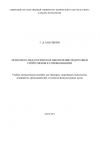Текст книги "Управление культурами"

Автор книги: Андрей Фетисов
Жанр: Управление и подбор персонала, Бизнес-Книги
сообщить о неприемлемом содержимом
Текущая страница: 6 (всего у книги 10 страниц) [доступный отрывок для чтения: 3 страниц]
Литература
1. Гуссерль Э. Идеи к чистой феноменологии и феноменологической философии. Т. 1. М., 1999.
2. Гуревич П. С. Философия культуры. М., 1995.
3. Ионин Л. Г. Социология культуры. М., 1996.
4. Козловски П. Культура постмодерна. М., 1997.
5. Ильин В. В., Ахиезер А. С. Российская цивилизация: содержание, границы, возможности. М., 2000.
6. Малиновский П. В. Кадровые «сэндвич-технологии». Планирование карьеры – дело самого карьериста // Со-Общение. 2002. № 6 (31).
7. Малиновский П. В. Российская государственная служба: дефицит профессионализма // Управление персоналом. 1999. № 4.
8. Мерфи Э. С. Good governance. Концепция универсального применения? // Internationale Politik. 2002. № 8.
9. Моль А. Социодинамика культуры. М., 1973.
10. Мотрошилова Н. В. Идеи Эдмунда Гуссерля как введение в феноменологию. М.: Феноменология – Герменевтика, 2003.
11. Петров М. К. Историко-философские исследования. М.: РОССПЭН, 1996.
12. Розин В. М. Культурология. М., 1998.
13. Сорокин П. А. Главные тенденции нашего времени. М., 1997.
14. Сорокин П. А. Социологические теории современности. М.: ИНИОН, 1992.
15. Флорида Р. Креативный класс: люди, которые меняют будущее. М.: ИД «Классика-XXI», 2005.
16. Тоффлер Э. Третья волна. М., 1999.
17. Фукуяма Ф. Конец истории? // Вопросы философии. 1990. № 3.
18. Хантингтон С. Столкновение цивилизаций? // Полис. 1994. № 1.
19. Хейзинга Й. Homo Ludens. М., 1992.
20. Щедровицкий П. Г. Инновационный потенциал профессионального сообщества // Со-Общение. 2006. № 2.
21. Щедровицкий П. Г. Программный подход в СМД-методологии // Программирование культурного развития: региональные аспекты. М., 1991. Вып. 1.
22. Perkin H. J. The third revolution: Professional society in international perspective. L., 1996.
23. Rosenau J. N. The future of politics // Future. Guildford, 1999. Vol. 31. N 9/10.
24. Alonso J. A. Globalisation, civil society, and the multilateral system // Development in practice. Oxford, 2000. Vol. 10. N 3–4.
25. Znaniecki Florian. Culturalism. Chapter 1 in Cultural Reality. Chicago: University of Chicago, 1919. Vol. 15. N 23.
Хрестоматия
Rosenau J. N. «Distant Proximities: Dynamics beyond Globalization» (на англ. яз).
Znaniecki F. Cultural Reality (на англ. яз).
Murphy E. С. «Good governance: Ein universal anwendbares konzept?» (Good governance: Концепция универсального применения?).
Щедровицкий П. Г. «Инновационный потенциал профессионального сообщества».
Флорида Р. «Креативный класс: люди, которые меняют будущее»
В хрестоматию включены отрывки и статьи основных российских и зарубежных авторов курса «Управление культурами» – Дж. Розенау, Ф. Знанецкого, Р. Флориды, П. Г. Щедровицкого и других. Знакомство с ними позволит студентам наиболее полно представить тематику курса и разобраться в таких сложных понятиях и новых явлениях, изучаемых в его рамках, как «глобальное управление», «профессиональная революция», «творческая цивилизация», «креативный класс», а также задуматься об антропологических вызовах XXI в. и о становлении новой цивилизационной эпохи.
Rosenau J. N.
Distant proximities: Dynamics beyond Globalization
Princeton University Press, 2003
Chapter 1. An Emergent Epoch
Globalization is bringing peoples closer apart and places further together.
John Rennie Short
The news on the state of the world is both good and bad. Each day brings word of a world inching slowly toward sanity even as it moves toward breakdown. And not only do these integrative and disintegrative events occur simultaneously, but more often than not they are also causally related. More than that, the causal links tend to cumulate and generate a momentum such that every integrative increment tends to give rise to a disintegrative increment, and vice versa. This intertwining of the good and the bad, the global and local, the public and the private, the coherent and incoherent – to mention only a few of the interactive polarities that dominate world affairs – is a central theme of the ensuing pages. It is a theme captured by the book’s title, by the idea that what seems remote in the present era also seems close-at-hand, thereby compelling individuals and collectivities alike to cope continuously with the challenge of distant proximities.
The same theme is implicit in the subtitle of the book. It does not refer to a new world order, an eventual world government, or a colonization of Mars. Rather, the subtitle highlights the insufficiency of globalization as a concept with which to organize understanding of world affairs. Not that the concept is vague or simply a buzzword shorn of meaning by being applied to too many diverse circumstances. On the contrary, there are concrete, empirical dynamics at work that can properly be regarded as processes and structures of globalization. But all the dynamics are extraordinarily complex and require considerable nuance to comprehend their deeper implications and widespread consequences. Beyond globalization, in other words, lies conceptual equipment that, if used as a supplement to the analytic tools commonly employed to probe globalization, can substantially clarify, enrich, and expand our grasp of the course of events as the twenty-first century unfolds.
Indeed, a central argument of the book is that the best way to grasp world affairs today requires viewing them as an endless series of distant proximities in which the forces pressing for greater globalization and those inducing greater localization interactively play themselves out. To do otherwise, to focus only on globalizing dynamics, or only on localizing dynamics, is to risk overlooking what makes events unfold as they do. As one cogent observer put it.
I use the local and the global as prisms for looking at the same thing… It would be wrong to think that you either work at one or the other, that the two are not constantly interpenetrating each other… What we usually call the global, far from being something which, in a systematic fashion, rolls over everything, creating similarity, in fact works through particularity, negotiates particular spaces, particular ethnicities, works through mobilizing particular identities, and so on.
Other analysts express a similar perspective by contending that globalization and localization unite at all spatial scales. There is little, and maybe nothing, that is global that does not have some sort of a local manifestation. And each local manifestation changes the global context. Place centeredness is the amalgam of global change and local identity. Every place reveals itself at a variety of scales. Local perceptions are shaped by global influences, the combinations of which process local actions. These in turn are fuelled by local aspirations, many of which are the product of global images and expectations. All these local activities accumulate to create chaotic but global outcomes.
It follows, then, that a secure grasp of world affairs requires, at the very least, forming a habit of pausing to assess any distant proximities that may underlie or flow from the situations in which one is interested.
In so doing, however, one quickly discovers that distant proximities are not simple interrelationships, readily discernible and easily understood. Distant proximities encompass the tensions between core and periphery, between national and transnational systems, between communitarianism and cosmopolitanism, between cultures and subcultures, between states and markets, between urban and rural, between coherence and incoherence, between integration and disintegration, between decentralization and centralization, between universalism and particularism, between pace and space, between the global and the local – to note only the more conspicuous links between opposites that presently underlie the course of events and the development or decline of institutions. And all these tensions are marked by numerous variants; they take different forms in different parts of the world, in different countries, in different markets, in different communities, in different professions, and in different cyberspaces, with the result that there is enormous diversity in the way people experience the distant proximities of which their lives are composed. Whatever the diversity, however, locating distant proximities at the center of our perspectives on politics enables us to avoid the disciplinary trap of maintaining an analytic separation between foreign and domestic politics, as is the case when international politics and comparative politics are treated as different fields of inquiry, with each holding constant the dynamics at work in the other.
To identify a variety of complex tensions and polarities, however, is not to imply that they necessarily involve zero-sum relationships. Many do have this characteristic, as is clearly indicated in the assertion that «the fundamental conflict in the opening decades of the new century… will not be between nations or even between trading blocs but between the forces of globalization and the territorially based forces of local survival seeking to preserve and redefine community». Yet, as will be seen, the tensions that sustain other polarities are nonzero-sum in character, with their globalizing dynamics serving to reinforce, or to be reinforced by, their localizing components. That is why distant proximities cannot be treated as simple relationships. They are rooted in complexity, in complementary as well as competitive processes.
It follows that distant proximities do not revolve around the attentiveness of people to news from abroad. Even if the widespread preoccupation with worldwide terrorism after the attacks on the World Trade Center and the Pentagon proves to be a temporary blip in a long-term pattern, to cite the numerous statistics depicting how little American media cover foreign developments and thereby sustain the parochialism of their audiences is not to negate the concept of distant proximities. Rather, the latter involve the foreign travel experiences of individuals and their friends, the messages they receive from relatives abroad, the ways in which their jobs are linked to or threatened by foreign trade, and a host of other word-of-mouth or electronic inputs that underlie the ever-greater interdependence of life in a shrinking world. Furthermore, while the parochialism of the American people may be considerable in terms of exposure to foreign news, the same cannot be said of counterparts in other countries, all of which have enough adjacent and regional neighbors to be continuously reminded of the proximity of distant events and trends. Nor may the parochialism of Americans return to earlier levels once the shock of the terrorist attacks has worn off. As one analyst put it three days after September 11, «This is the end: the end of an era, the era of our invulnerability. We will recover physically, even psychologically, but nothing will ever be quite the same again. A barrier has been irrevocably breached: a barrier against the world outside».
To comprehend the nature and dynamism of distant proximities, clearly we need to explore both the phenomena viewed as distant and those considered proximate before assessing how the tensions resulting from their interactions play out in diverse contexts. To do so, of course, is to move beyond objective circumstances. Distance is not measured only in miles across land and sea; it can also involve less tangible spaces, more abstract conceptions in which distance is assessed across organizational hierarchies, event sequences, social strata, market relationships, migration patterns, and a host of other nonterritorial spaces. Thus to a large extent distant proximities are subjective appraisals – what people feel or think is remote, and what they think or feel is close-at-hand. There is no self-evident line that divides the distant from the proximate, no established criteria for differentiating among statistics or situations that are reflective of either the more remote or the close-at-hand environment. In other words, nearness and farness connote scale as well as space. Both are ranges across which people and their thoughts roam; and as they roam, they can be active in both geographic locales and scalar spaces that have been socially constructed. Each is a context, a «habitat of meaning», a mind-set that may often correspond with spatial distance even as there are other scalar contexts that can make the close-at-hand feel very remote and the faraway seem immediately present.
To ponder the nature and ramifications of distant proximities in a time of vast changes, therefore, is to consider what, when, how, and why people experience some dimensions of their lives and some phenomena in their perceptual space as marvelously or threateningly close. In some cases wide inter subjective agreement prevails as to the appropriate spatial classification; in other cases controversy is intense over where lines between the distant and the proximate should be drawn; and it is both the areas of consensus and the disputes they sustain that underlie the dynamism of distant proximities as they are experienced by both individuals and their collectivities.
Clarifying the Polarities
Having already mentioned several polarities, it is important to clarify their relations to each other and the sense in which they differentiate good from bad. Most notably, there is no necessary connection between the good-and-bad dimension of any of the polarities just noted. Some aspects of the several poles are desirable, and some are noxious. Globalization has both positive and negative features, as does localization, and much the same can be said about the coherence-incoherence and integration-disintegration polarities. Coherence and integration normally seem preferable to incoherence and disintegration, but it is not difficult to think of situations – South Africa during the apartheid era comes quickly to mind – with an excess of coherence that could benefit from a period of incoherence and disintegration.
In a like manner, nothing in the pages that follow should be interpreted as implying that the centralizing processes inherent in globalization are preferable to the decentralizing processes that accompany localization. It is all to the good when globalizing dynamics lead international organizations to concert their efforts against corruption or when corporations converge around new, more open attitudes toward environmental problems, but it is surely bad if states collude to ignore corrupt practices and corporations maintain their position that environmental threats have yet to be demonstrated. Similarly, it is all to the good when localizing dynamics lead to decentralizing processes in which opposition voices are encouraged and democratic practices expanded, but it is surely bad if these processes result in a fragmentation that tears communities apart and facilitates the rule of petty tyrants.
In short, more so than in the past because time and space have been so rapidly compressed, we live in an era of pervasive contradictions that give rise to polarities subject to diverse normative judgments. Such evaluations cannot be avoided, but they can be explicated as one works through the contradictions and interprets their implications. In this way there ought be no confusion over the normative stance that underlies any empirical conclusions the analysis yields. Depending on the consequences to which they give rise – whether they elevate or denigrate individuals or groups – distant proximities can be viewed as expressive of a trend that portends future progress or one that points toward retrogression. In the case of some distant proximities, of course, their consequences have still to become fully manifest, and their normative implications thus remain correspondingly obscure.
Since distant proximities encompass polarities that are bound to take inquiry beyond globalization, it would be a mistake to view them as little more than a means of analyzing the processes and dynamics of globalization. Conceived in this larger context, globalization is but one component of the transformative dynamics that underlie the emergence of a new epoch in the human condition. It is, to be sure, a major component, but all too many analyses suffer from treating it as the primary component and thus risk underplaying the complexity of the emergent epoch. There is a need, for example, to recognize that localization is also a powerful force at work throughout the world, that cities, provinces, and other subnational groups are also seeking to realize their goals, that by 2030 some 60 percent of the world’s people will live in cities, and that consequently localization is multiplying the range of policy environments as globalization shrinks the world. We live in a messy world, one that is marked by sharp contradictions comprehensible only through nuanced analysis that accords significance to numerous forces that can – and often do – undermine, limit, or otherwise redirect globalizing processes.
Violins offer a useful metaphor for distinguishing between previous epochs in world affairs and the complexities of the one that is presently emerging. Just as a poorly built violin halts and dampens the sound of each note, confining it to its own limited frequency and ceasing as soon as the bow leaves the string, so has the world in earlier epochs tended to retain the effects of events locally, muffling their impact on other systems and restraining their duration. In contrast, the expansionary, enduring character of distant proximities in the present global system is analogous to a good violin. Every note triggers a series of overtones that resonate with the remaining strings through the body of the whole instrument, both amplifying and sustaining the sound. In the case of the violin it is the difference between mere sounds and music; in world affairs it is the difference between international politics and dynamics beyond globalization.
Labeling the Epoch
But how to denote the emergent epoch? «Distant proximities» suggest its ironies, but it is hardly a label that would satisfy the many observers who seek a more descriptive designation of the new historical period that has accompanied the end of the twentieth century and the onset of the twenty-first. For some time attempts to summarize the numerous changes that generated the new period have followed two lines of reasoning and resulted in two main labels for the emergent epoch. The two approaches differ greatly in several respects – one being pragmatic and framed by politicians and journalists, while the other is philosophical and has evolved among intellectuals – but they share a lack of specificity about the essential underpinnings and nature of world affairs at the outset of a new millennium. The pragmatic line of reasoning acknowledges that present-day patterns and institutions are quite different from those of prior eras, but it does not seek to evaluate, much less synthesize, the differences or their long-run implications. Rather, it simply assumes the end of the superpower rivalry between the United States and the Soviet Union unleashed diverse processes that are altering the practices through which the politics, economics, and social life of communities, nations, and the world are sustained. Lacking specificity, the pragmatic approach tends to treat every development, whether it be familiar or unusual, as expressive of the new historical epoch, and thus it uses a label, the «post-Cold War» era, which hints at changes and differences without indicating what these might be. Indeed, by employing such a label, pragmatists conclude that the present is a congeries of unsystematic, even unrelated, forces that are propelling the world into an uncertain future. In addition, by positing conditions as «post» an earlier era, the pragmatic perspective implies that the present is a transitional period, as if new historical developments have to evolve and generate new global structures before the world can settle once again into stable circumstances such as marked the Cold War era of 1945–1990, the interwar period of 1918–1939, or the industrial age of the nineteenth century.
The other, more philosophical response to the dynamics that are transforming the present-day world is somewhat more precise in terms of specifying what has changed, but it also is murky about what sustains the changes and where they may be taking the world. And thus it, too, uses the «post» prefix as part of its label for the epoch, thereby also suggesting that a multiplicity of diverse and unstructured forces are at work that offer no hint as to what the world’s future may be like. In this case the label is that of «post-modernism», a school of thought that has different meanings for different postmodernists who nonetheless share the conviction that basic changes have moved the world beyond modernity or, at least, into «late modernity». Whether the era is seen as «post» or «late», adherents of the various postmodernisms also share the belief that modernity has run its course because the notions of science and rationality that distinguish it have proven to be ill-founded. After all, many post-modernists assert, two devastating world wars, a deep economic depression, and the hydrogen bomb mark the age of science and rationality – hardly a recommendation for a modernist perspective. For all their criticisms of modernity, however, postmodernists do not offer an understanding of where the world is today and where it is likely to be tomorrow. Indeed, while some of them view the future as an ongoing process of constructed expectations, many postmodernists are inclined to argue that speculation about future developments is wasted effort, that any scenarios depicting paths into the future are hidden political moves designed to advance the particular agendas of the scenarist.
If it is the case that distant proximities have become so pervasive as to serve as the basis for an analytic framework, then the absence of a label suggestive of the nature, processes, and structure of the emergent epoch is especially glaring. Hence, in order to encourage a focus on the dynamics whereby the shrinking of social and geographic distances has rendered the environment of people, organizations, and communities both distant and proximate, here a concocted label will be used to convey the essential nature of the epochal transformation. The label is «fragmegration», which is intended to suggest the pervasive interaction between fragmenting and integrating dynamics unfolding at every level of community. It is admittedly an awkward and grating label, but as such it serves as a constant reminder that the world has moved beyond the condition of being «post» its predecessor to an era in which the foundations of daily life have settled into new and unique rhythms of their own. Equally important, the fragmegration label captures in a single word the large degree to which these rhythms consist of localizing, decentralizing, or fragmenting dynamics that are interactively and causally linked to globalizing, centralizing, and integrating dynamics.
Of course, the fragmegration label can easily lead to oversimplification and misinterpretation. It risks treating localizing and decentralizing processes as forms of fragmentation and equating globalizing and centralizing dynamics with processes of integration. Such a conflation of these polarities would indeed be misleading. Localizing and decentralizing dynamics need not be the same as fragmenting processes, even though all three share a movement away from whole systems and toward less encompassing subsystems. To decentralize, for example, may well be to calculate that advantages can be enjoyed by voluntarily breaking up into smaller units, whereas to fragment is to imply that breakups derive from irresolvable tensions and conflicts. Similarly, globalizing and centralizing processes may not be the equivalent of those that serve to integrate. On the other hand, since the components of the several polarities can be overlapping and interrelated, merging them into a single label is not entirely an oversimplification. If it is viewed as an indicator of complexity, and if the dangers of oversimplification are recognized, the fragmegration label has the virtue of sensitizing us to the contradictory tensions wherein the world is simultaneously moving in opposite directions.
Another virtue of the fragmegration concept is that it inhibits narrow approaches to globalization. Much of the exploding literature on globalization casts its dynamics in strict economic terms – as processes that sustain or advance the power of corporations, that widen the rich-poor gap, that foster the integration of markets, that underlie the flow of investments – but such formulations seem needlessly limited. Diverse economic factors are indeed central to the configurations of the emergent epoch, but so are cultural, social, political, and ecological processes, and their salience is highlighted by focusing on the ways in which local and global forces shape each other.
Fragmegration also serves to underscore the contradictions, ambiguities, complexities, and uncertainties that have replaced the regularities of prior epochs. Consisting of nonlinear processes in which every effect is a cause of yet another outcome in a complex and endless array of feedback loops, these contradictions, ambiguities, complexities, and uncertainties are, in effect, the regularities of our age of fragmegration. And no less important, they are rooted in the decline of ideological belief systems as a consequence of scientific developments and the clusters of values that constitute modernity. In the absence of viable alternative belief systems, many people can experience insecurity about the meaningfulness of life. Even before terrorism came brutally to the United States, the recent generations whose lives had been free of war and marked by high degrees of comfort and not a little affluence felt vulnerable and insecure. Paradoxically, the more risk-free the world seemed, the more risky it felt. In the words of one observer.
Now, is our world more dangerous?.. It is. We are asking more of it, more comfort and therefore we are more vulnerable. The more secure we are, the more we feel the danger of losing our security. There are easy ways to inflict major pain with no major effort. People can intrude on our financial and national-security systems in much easier ways. This is because of the interconnectedness of the world and its infrastructures.
The sense of vulnerability, moreover, can lead to extreme reactions since unfortunately change, complexity and information overload are abstract phenomena, which are difficult to grasp. Therefore few people have as yet understood that they are at the root of the anxiety they feel. When trying to rationalize their vague feelings of unease, people will rather look for more easily recognizable causes, such as unemployment, pollution, crime, corruption or immigration. These phenomena, which have become both more visible and less tolerated, play the role of scapegoat: they… may lead to backlashes and irrational reactions, such as racism, intolerance and persecution of groups that are held responsible.
Incisive empirical examples of the fragmegrative contradictions that pervade the emergent epoch abound. Quintessentially illustrative of the simultaneity inherent in such situations were the circumstances surrounding the Seattle meeting of the World Trade Organization (WTO) in late 1999: just as the WTO convened in an attempt to extend global integration of trade practices, so did numerous private groups and organizations converge on the city to march in the streets in opposition to the WTO and its policies. Perhaps even more illustrative were the terrorist attacks on the United States in September 2001: just as their disintegrative dimensions were rooted in resentments and hatreds fomented by poverty and challenges to tradition in the underdeveloped world, so were their integrative dimensions manifest in the pervasive sense of unity that the attacks fostered among Americans and their allies. Another contradictory situation is evident in this account of a period in the Israeli-Palestinian conflict:
What ails the peace process is not just a crisis of confidence. It’s a crisis of logic. It’s not only that each side doesn’t trust the other; it’s that nothing makes sense. Opposite causes produce the same effect: There are suicide bombers when the peace process moves ahead and suicide bombers when the process is stuck. And the same causes produce opposite effects: Mr. Netanyahu strikes a Hebron deal one day and undermines it the next by building in Har Homa; Mr. Arafat exposes a cell of Palestinian suicide bombers in Beit Sahur one day and kisses the leader of Hamas the next. Closure of the territories increases Israel’s security and decreases Israel’s security. Everything that happens, for good or ill, seems utterly random. Oslo is no longer a peace process. It’s a Tolstoy novel.
Of course, fragmegrative dynamics are not always as obvious as they are in the case of these examples, but the more one gets accustomed to viewing the course of events through fragmegrative lenses, the more will the underlying tensions and contradictions become manifest. There may be situations that are free of fragmegrative contradictions, but one would be hard-pressed to identify them on the current world scene.
Stated more generally, where people came to expect the Soviet-American rivalry to shape the course of events in the Cold War era, and where they became used to the ways in which U.S. hegemony shaped outcomes in the brief post-Cold War period, today they appear to have adjusted to the realization that outcomes stem from multiple sources, that they are transitory and ever subject to reversal, and that what happens at one level of community can rapidly and unexpectedly cascade across other levels. For reasons elaborated in subsequent chapters, in other words, elites, activists, and ordinary persons alike have come to understand intersubjectively that their lives are intertwined in crazy-quilt ways that may often be enhancing and perhaps just as often denigrating.
Правообладателям!
Данное произведение размещено по согласованию с ООО "ЛитРес" (20% исходного текста). Если размещение книги нарушает чьи-либо права, то сообщите об этом.Читателям!
Оплатили, но не знаете что делать дальше?




































